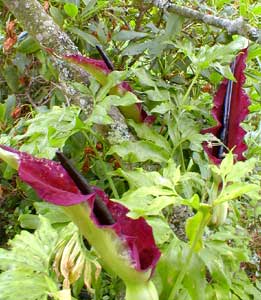
Voodoo Lily; aka,
Dragon Lily, or
Dragon Arum
"I hate flowers.
I paint them because
they're cheaper than models
and they don't move."
-Georgia O'Keeffe
(1887-1986)
(1887-1986)
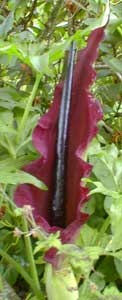 Dracunculus vulgaris (aka Arum dracunculus) is variously called the Dragon Arum, Voodoo Lily, Ragons, Snake Lily, Black Arum, Black Dragon, Dragonwort, & Stink Lily. In Greece it is called Drakondia, the dragon or serpent being the long spadex inside the enormous maroon-lipped spathe.
Dracunculus vulgaris (aka Arum dracunculus) is variously called the Dragon Arum, Voodoo Lily, Ragons, Snake Lily, Black Arum, Black Dragon, Dragonwort, & Stink Lily. In Greece it is called Drakondia, the dragon or serpent being the long spadex inside the enormous maroon-lipped spathe.It is native to the Balkans, to Mediterranean Europe, Greece, the isle of Crete & the Aegean Islands, all the way to Southwest Turkey. In some places it's a veritable weed in its natural settings, albeit a weed of splendid countenance.
Though it looks like it ought to be tropical, it is not; & it transfers to the temperate garden with great ease, doing well in zones 5-8.
 Northwest gardeners have reported them spreading quite wildly, & requiring no special attention of any kind. They spread by self-seeding & by bulb offsets. If the seedheads are not collected, they will eventually fall over in the garden, where beetles or ants cart them away, spreading the voodoo lily more distantly. The penultimate photo below shows one of the green seed cobs in August. The final photo shows the ripened cob in October, when the stalk has softened has toppled to the ground so insects will clean & disperse the seeds.
Northwest gardeners have reported them spreading quite wildly, & requiring no special attention of any kind. They spread by self-seeding & by bulb offsets. If the seedheads are not collected, they will eventually fall over in the garden, where beetles or ants cart them away, spreading the voodoo lily more distantly. The penultimate photo below shows one of the green seed cobs in August. The final photo shows the ripened cob in October, when the stalk has softened has toppled to the ground so insects will clean & disperse the seeds.Garden Resources of Vashon Island grows these from bulbs for the retail nurseries, & we got ours from Savage Nurseries in nearby Kingston.
The first one we obtained was in 2002 & though all we got from it the first year was foliage, I didn't care, I got two more & planted them in a group in 2003. That year they began to get quite large, then died back before blooming, I was never certain why, but we did have some record-hot summer days & perhaps the voodoo lilies got too little deep watering.
They struck me as rewarding plants even for the unusual foliage, but the real pay-off was when they finally bloomed, all three together, in June 2004, & again in 2005. What phantasmagoric flowers!
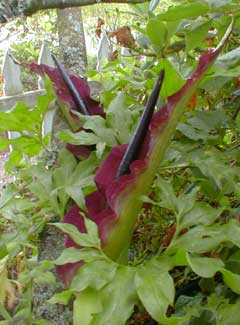 The very striking deep purple-black spathe sends upward a shimmering purple-black "jack" which can grow to as long as fifty inches, though a foot length is more likely & still mightily impressive. This black spadix extends from the rather vaginal spathe, leading this aroid to be called "amorphallus" in form.
The very striking deep purple-black spathe sends upward a shimmering purple-black "jack" which can grow to as long as fifty inches, though a foot length is more likely & still mightily impressive. This black spadix extends from the rather vaginal spathe, leading this aroid to be called "amorphallus" in form.Long before blooming, in March when these are merely foot-tall stalks or pseudostems, with as few as three leaves on top, the plants are already very pretty. The thick sturdy stalks look like those on certain jack-in-the-pulpits with a snakeskin pattern, & the leaves arranged in sets of three look like an ornate ruffly version of trilliums.
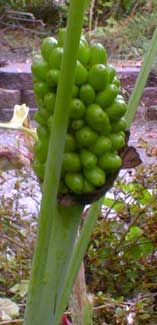 The leaves continue to develop into a spiral & have sometimes been described as looking like antlers. But the beauty at this stage barely hints of amazement to come, for you must first of all imagine a brightly colored spathe flower almost big enough to stick your head in (except you'd have to hold your breath from the odor within).
The leaves continue to develop into a spiral & have sometimes been described as looking like antlers. But the beauty at this stage barely hints of amazement to come, for you must first of all imagine a brightly colored spathe flower almost big enough to stick your head in (except you'd have to hold your breath from the odor within).The eerie erotic beauty of this plant can be a little shocking. If this plant is not widely popular, it is because it needs to attract carrion-eating pollinators, so will briefly smell bad, for which reason the plant has been jestingly known as "Netta Stathams' Old Smelly," because Statham, a hosta breeder, grew so many of them.
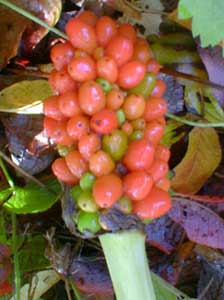 Fortunately the dungy rotten meaty odor only occurs when the inflourescence is mature & lasts only long enough to attract a few flies, then the plant is satisfied & ceases to stink. Generally the bad odor only lasts one day. Ours is planted far enough back in the garden we never smell it at all; what a mistake it would be, however, to plant a lot of them right beside the door.
Fortunately the dungy rotten meaty odor only occurs when the inflourescence is mature & lasts only long enough to attract a few flies, then the plant is satisfied & ceases to stink. Generally the bad odor only lasts one day. Ours is planted far enough back in the garden we never smell it at all; what a mistake it would be, however, to plant a lot of them right beside the door.But in 2005 I stood on the sidewalk admiring the array of colorful shiny carrion flies buzzing about the voodoo lilies, & from four feet away I couldn't smell them even at their height of fly-attracting, so there is really no reason to worry about the odor.
Ours are doing fine in bright shade but with very regular watering so they never dry out, they're fine in full sun too. They can be planted among dahlias which also do great in full sun with persistent moisture in well-draining soil.
The root is toxic, but has been gathered & processed by cooking & pounding to obtain edible starch called Arum Arrowroot, with which to pad out wheat flour in times of limited resources or famine.